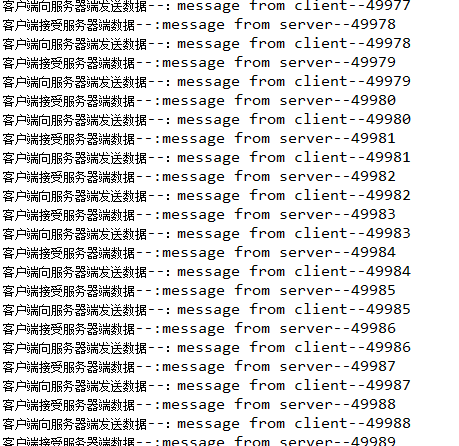NIO:即非阻塞式IO
视频教程: https://chuanke.baidu.com/v1982732-211322-1316084.html
使用步骤:
1、创建 ServerSocketChannel 和业务处理线程池。
2、绑定监听端口,并配置为非阻塞模式。
3、创建 多路复用器Selector,将之前创建的 ServerSocketChannel 注册到 Selector 上,监听 SelectionKey.OP_ACCEPT。
4、循环执行 Selector.select() 方法,轮询就绪的 Channel。
5、Selector轮询就绪的 Channel 时,如果是处于 OP_ACCEPT 状态,说明是新的客户端接入,调用 ServerSocketChannel.accept 接收新的客户端。
6、设置新接入的 SocketChannel 为非阻塞模式,并注册到 Selector 上,监听 OP_READ。
7、如果Selector轮询的 Channel 状态是 OP_READ,说明有新的就绪数据包需要读取,则构造 ByteBuffer 对象,读取数据。
先启动服务端,不停监听客户端连接
服务端代码
import java.io.IOException; import java.net.InetSocketAddress; import java.nio.ByteBuffer; import java.nio.channels.SelectionKey; import java.nio.channels.Selector; import java.nio.channels.ServerSocketChannel; import java.nio.channels.SocketChannel; import java.util.Iterator; public class NIOServer { /*标识数字*/ private int flag = 0; /*缓冲区大小*/ private int BLOCK = 4096; /*接受数据缓冲区*/ private ByteBuffer sendbuffer = ByteBuffer.allocate(BLOCK); /*发送数据缓冲区*/ private ByteBuffer receivebuffer = ByteBuffer.allocate(BLOCK); //选择器 private Selector selector; public NIOServer(int port) throws IOException { //1. 获取通道, 打开服务器套接字通道 ServerSocketChannel serverSocketChannel = ServerSocketChannel.open(); //2. 切换到非阻塞模式 serverSocketChannel.configureBlocking(false); //3. 绑定连接的端口 serverSocketChannel.socket().bind(new InetSocketAddress(port)); //4. 获取选择器 selector = Selector.open(); //5. 通道注册到选择器上,指定监听事件:接收。……等待连接 serverSocketChannel.register(selector, SelectionKey.OP_ACCEPT); System.out.println("Server Start----8888:"); } //监听 public void listen() throws IOException { while(true) { //6. 循环获取选择器上已经“准备就绪”的事件,返回的int值表示有多少个通道在上一次select后发生了注册事件 int nKeys = selector.select(); if(nKeys>0){ //7. 获取当前选择器中所有注册的选择键(已就绪的监听事件) Iterator<SelectionKey> iterator = selector.selectedKeys().iterator(); while(iterator.hasNext()){ //8. 获取“准备就绪”的事件 SelectionKey selectionKey = iterator.next(); //9. 判断具体是什么事件准备就绪,开始处理请求 handleKey(selectionKey); iterator.remove(); } } else { try { Thread.sleep(1000); } catch (InterruptedException e) { e.printStackTrace(); } } } } // 处理请求 private void handleKey(SelectionKey selectionKey) throws IOException { // 接受请求 ServerSocketChannel server = null; SocketChannel client = null; String receiveText; String sendText; int count=0; // 此选择键的通道是否已准备好接受新的套接字连接。 if (selectionKey.isAcceptable()) { // 返回为之创建此选择键的通道。 server = (ServerSocketChannel) selectionKey.channel(); //10. 若“接收就绪”,获取客户端连接 client = server.accept(); //11. 切换到非阻塞模式 client.configureBlocking(false); //12. 通道注册到选择器上,指定监听事件:读 就绪 client.register(selector, SelectionKey.OP_READ); } else if (selectionKey.isReadable()) { // 返回为之创建此键的通道。 client = (SocketChannel) selectionKey.channel(); //将缓冲区清空以备下次读取 receivebuffer.clear(); //读取服务器发送来的数据到缓冲区中 count = client.read(receivebuffer); if (count > 0) { receiveText = new String(receivebuffer.array(),0,count); System.out.println("服务器端接受客户端数据--:"+receiveText); client.register(selector, SelectionKey.OP_WRITE); } } else if (selectionKey.isWritable()) { //将缓冲区清空以备下次写入 sendbuffer.clear(); // 返回为之创建此键的通道。 client = (SocketChannel) selectionKey.channel(); sendText="message from server--" + flag++; //向缓冲区中输入数据 sendbuffer.put(sendText.getBytes()); //将缓冲区各标志复位,因为向里面put了数据标志被改变要想从中读取数据发向服务器,就要复位 sendbuffer.flip(); //输出到通道 client.write(sendbuffer); System.out.println("服务器端向客户端发送数据--:"+sendText); client.register(selector, SelectionKey.OP_READ); } } public static void main(String[] args) throws IOException { int port = 8888; NIOServer server = new NIOServer(port); server.listen(); } }
心得:
1、第5步中,先把服务端通道注册到选择器上,该选择器等待accept接收客户端消息
2、转到第9步,处理请求,如果isAcceptable()=true,准备好接收客户端了,获取客户端连接
3、第12步,客户端通道注册到选择器上,并指定监听读。然后,继续走到listen()方法的循环体中,
4、 这次循环中,上面已获取客户端连接,nKeys >0了,selectionKey 是监听读
5、又到第9步,isReadable()=true,说明是读事件,开始操作数据,通道读取缓冲区
客户端代码
import java.io.IOException; import java.net.InetSocketAddress; import java.nio.ByteBuffer; import java.nio.channels.SelectionKey; import java.nio.channels.Selector; import java.nio.channels.SocketChannel; import java.util.Iterator; import java.util.Set; public class NIOClient { /*标识数字*/ private static int flag = 0; /*缓冲区大小*/ private static int BLOCK = 4096; /*接受数据缓冲区*/ private static ByteBuffer sendbuffer = ByteBuffer.allocate(BLOCK); /*发送数据缓冲区*/ private static ByteBuffer receivebuffer = ByteBuffer.allocate(BLOCK); /*服务器端地址*/ private final static InetSocketAddress SERVER_ADDRESS = new InetSocketAddress("127.0.0.1", 8888); public static void main(String[] args) throws IOException { // TODO Auto-generated method stub // 打开socket通道 SocketChannel socketChannel = SocketChannel.open(); // 设置为非阻塞方式 socketChannel.configureBlocking(false); // 打开选择器 Selector selector = Selector.open(); // 注册连接服务端socket动作 socketChannel.register(selector, SelectionKey.OP_CONNECT); // 连接 socketChannel.connect(SERVER_ADDRESS); // 分配缓冲区大小内存 Set<SelectionKey> selectionKeys; Iterator<SelectionKey> iterator; SelectionKey selectionKey; SocketChannel client; String receiveText; String sendText; int count=0; while (true) { //选择一组键,其相应的通道已为 I/O 操作准备就绪。 //此方法执行处于阻塞模式的选择操作。 selector.select(); //返回此选择器的已选择键集。 selectionKeys = selector.selectedKeys(); //System.out.println(selectionKeys.size()); iterator = selectionKeys.iterator(); while (iterator.hasNext()) { selectionKey = iterator.next(); if (selectionKey.isConnectable()) { System.out.println("client connect"); client = (SocketChannel) selectionKey.channel(); // 判断此通道上是否正在进行连接操作。 // 完成套接字通道的连接过程。 if (client.isConnectionPending()) { client.finishConnect(); System.out.println("完成连接!"); sendbuffer.clear(); sendbuffer.put("Hello,Server".getBytes()); sendbuffer.flip(); client.write(sendbuffer); } client.register(selector, SelectionKey.OP_READ); } else if (selectionKey.isReadable()) { client = (SocketChannel) selectionKey.channel(); //将缓冲区清空以备下次读取 receivebuffer.clear(); //读取服务器发送来的数据到缓冲区中 count=client.read(receivebuffer); if(count>0){ receiveText = new String( receivebuffer.array(),0,count); System.out.println("客户端接受服务器端数据--:"+receiveText); client.register(selector, SelectionKey.OP_WRITE); } } else if (selectionKey.isWritable()) { sendbuffer.clear(); client = (SocketChannel) selectionKey.channel(); sendText = "message from client--" + (flag++); sendbuffer.put(sendText.getBytes()); //将缓冲区各标志复位,因为向里面put了数据标志被改变要想从中读取数据发向服务器,就要复位 sendbuffer.flip(); client.write(sendbuffer); System.out.println("客户端向服务器端发送数据--:"+sendText); client.register(selector, SelectionKey.OP_READ); } } selectionKeys.clear(); } } }
运行效果:
